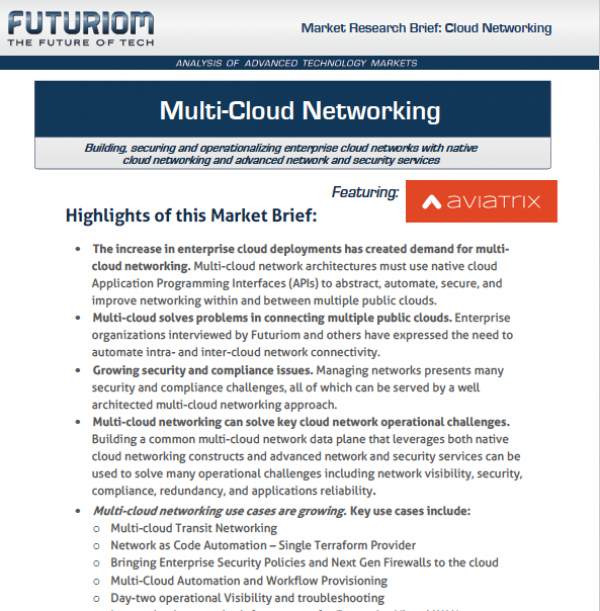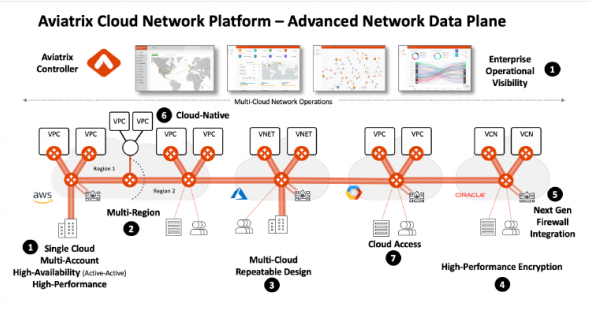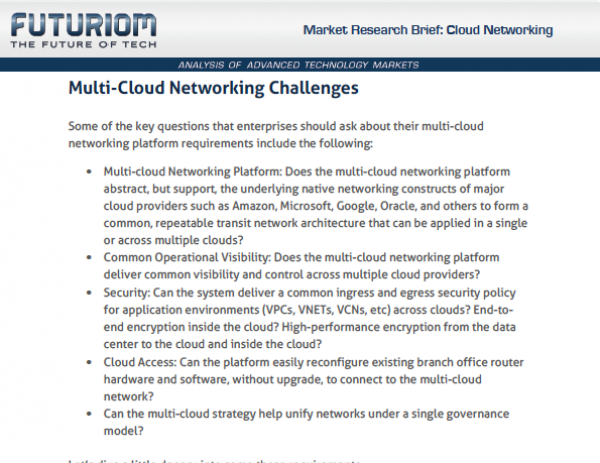Inside Multi-Cloud Networking Trends

We've been following key trends in cloud networking, and multi-cloud is where there is a huge opportunity over the next few years. Our new Multi-Cloud Networking Market Brief keeps you up to date on these trends. This is a FREE report sponsored by Aviatrix. You can download it here now.
As cloud becomes the new IT platform, established, on-premises infrastructure will migrate to a multi-cloud future. Multiple clouds, or multi-clouds, will become key to IT strategy, as organizations figure out the best way to leverage and balance their applications and data in the cloudscape.
The network has fallen behind. Cloud networks will need to evolve to support the scale of data movement and processing. The tools to connect multiple clouds are limited. Many public cloud constructs are proprietary and not concerned with connecting to clouds outside of their own service. Essentially, they are islands of networks that must be connected. As applications become increasing distributed among clouds, it will become more important to deliver automated, secure, and high-performance multi-cloud networking.
IT organizations need a repeatable architecture with common services, common operational capabilities, and common security constructs across multiple cloud environments. Trying to understand and train staff to deal with the complexities of cloud networking for a single cloud is difficult. Doing this for multiple clouds is nearly impossible with the skills gap and limited resource pool. Talent is being quickly sucked up by the service providers themselves and large enterprises who have recognized the challenge and targeted local talent. Download the report here right now.
Highlights of this Market Trend Brief:
- The increase in enterprise cloud deployments has created demand for multi-cloud networking. Multi-cloud network architectures must use native cloud Application Programming Interfaces (APIs) to abstract, automate, secure, and improve networking within and between multiple public clouds.
- Multi-cloud solves problems in connecting multiple public clouds. Enterprise organizations interviewed by Futuriom and others have expressed the need to automate intra- and inter-cloud network connectivity.
- Growing security and compliance issues. Managing networks presents many security and compliance challenges, all of which can be served by a well-architected multi-cloud networking approach.
- Multi-cloud networking can solve key cloud network operational challenges. Building a common multi-cloud network data plane that leverages both native cloud networking constructs and advanced network and security services can be used to solve many operational challenges, including network visibility, security, compliance, redundancy, and applications reliability.
- Multi-cloud networking use cases are growing. Key use cases include single Terraform provider, enterprise security policies and next-gen firewall cloud management, multi-cloud automation and workflow provisioning, day-two operational visibility and troubleshooting, leveraging hyperscaler infrastructure for enterprise virtual WAN, and simplified enterprise acquisition and integration.
- Abstraction-driven automation. The future of multi-cloud networking will be driven by using APIs to connect a variety of public cloud frameworks and platforms that simplify the creation and operation of multi-cloud networks.


























